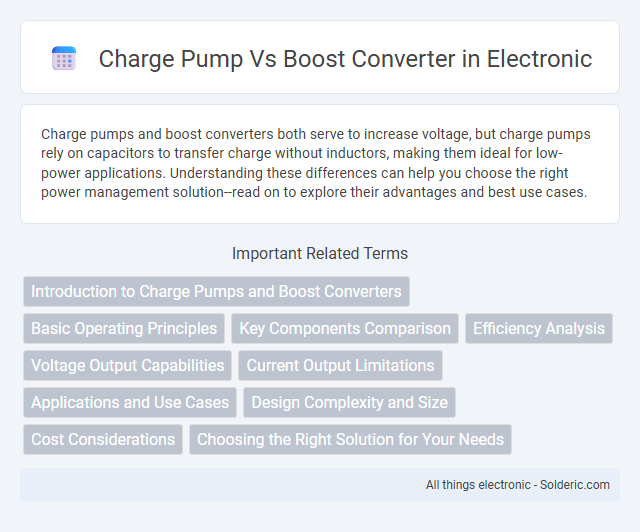Charge pumps and boost converters both serve to increase voltage, but charge pumps rely on capacitors to transfer charge without inductors, making them ideal for low-power applications. Understanding these differences can help you choose the right power management solution--read on to explore their advantages and best use cases.
Comparison Table
| Feature | Charge Pump | Boost Converter |
|---|---|---|
| Working Principle | Uses capacitors to transfer charge and increase voltage | Uses an inductor, switch, and diode to boost voltage |
| Voltage Gain | Fixed multiples of input voltage (e.g., 2x, 3x) | Variable, adjustable by duty cycle |
| Efficiency | Moderate; efficiency drops with higher output current | High efficiency over wide load range |
| Output Current | Low to moderate current capability | Supports high output current |
| Complexity | Simple, fewer external components | More complex, requires inductors and control circuitry |
| Noise | Low EMI, low switching noise | Higher EMI due to switching inductor |
| Applications | Small portable devices, low current boost | Power supplies, battery-powered devices needing high current |
Introduction to Charge Pumps and Boost Converters
Charge pumps and boost converters are essential DC-DC converter topologies used to increase voltage levels in electronic circuits. Charge pumps use capacitors as energy storage elements, transferring charge through switches to generate higher voltages with low noise and compact size, ideal for low-power applications. Boost converters rely on inductors and switching elements to store and transfer energy, offering higher efficiency and continuous output current suitable for higher power demands and variable load conditions.
Basic Operating Principles
Charge pumps transfer energy by switching capacitors between different configurations to increase voltage through discrete charge steps, making them ideal for low-power applications with simple voltage doubling or inversion needs. Boost converters operate using an inductor, switch, diode, and capacitor to increase voltage by storing energy in the magnetic field of the inductor during the switch's ON phase and releasing it to the output during the OFF phase, suitable for higher power and efficiency requirements. Charge pumps rely on capacitor charge redistribution without inductors, while boost converters use inductive energy storage for continuous and efficient voltage step-up.
Key Components Comparison
Charge pumps primarily consist of capacitors and switches operating in a non-inductive manner, enabling voltage conversion through charge transfer without magnetic components. Boost converters rely on inductors, transistors, diodes, and capacitors to step up voltage by storing energy in the magnetic field of the inductor and releasing it at a higher voltage. The absence of inductors in charge pumps makes them more compact and efficient for low-current applications, while boost converters handle higher power demands with greater voltage flexibility.
Efficiency Analysis
Charge pumps typically offer higher efficiency at low power levels due to their simpler design and fewer energy conversion stages, often achieving efficiencies above 90%. Boost converters, while capable of handling higher currents and voltages, may experience efficiency losses ranging from 70% to 85% because of switching losses and inductor resistance. Efficiency in charge pumps is heavily influenced by the capacitive load and switching frequency, whereas boost converters' efficiency depends on inductance quality and switching topology.
Voltage Output Capabilities
Charge pumps are ideal for low to moderate voltage output applications, typically providing multiples of the input voltage through switched capacitor circuits, but their output current is limited. Boost converters offer higher voltage output capabilities with greater current drive, utilizing inductors and switched-mode power supply techniques to step up voltage efficiently. The choice between them depends on the required voltage level, load current, and efficiency considerations in power management design.
Current Output Limitations
Charge pumps are limited by their capacitive switching design, typically providing low current output suitable for small loads, often in the range of a few tens to hundreds of milliamps. Boost converters use inductors and active switching elements, enabling higher current outputs, often several amps, making them ideal for applications requiring substantial power delivery. Choosing between these depends on your current requirements, with charge pumps fitting low-current, compact designs and boost converters preferred for higher current demands.
Applications and Use Cases
Charge pumps excel in low-power applications such as EEPROM programming, LCD biasing, and small sensor devices where compact size and minimal external components are critical. Boost converters are preferred for higher power applications like battery-powered devices, LED drivers, and DC motor control, providing efficient voltage step-up with adjustable output. Your choice depends on power requirements, efficiency needs, and available board space.
Design Complexity and Size
Charge pumps offer simpler design complexity and smaller size by using capacitors for voltage conversion, eliminating the need for inductors. Boost converters require inductors and more complex control circuitry, resulting in larger physical size and increased design challenges. This makes charge pumps ideal for compact applications where space and simplicity are critical.
Cost Considerations
Charge pumps typically offer a lower cost solution due to fewer external components and simpler circuit design, making them suitable for low-power applications. Boost converters, while more expensive because of inductors and complex control circuitry, provide higher efficiency and flexibility for a wider range of input voltages and output power levels. Selecting between charge pump and boost converter depends on balancing cost with performance requirements in the intended application.
Choosing the Right Solution for Your Needs
Charge pumps are ideal for low-current, compact applications due to their simple design and high efficiency at lower power levels. Boost converters excel in higher power scenarios, offering greater voltage gain and flexibility with varying input voltages. Assessing your load requirements, efficiency targets, and circuit complexity is crucial to selecting the optimal power conversion method for your project.
Charge Pump vs Boost Converter Infographic

 solderic.com
solderic.com